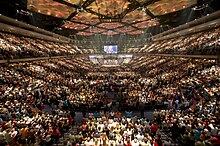Megachurch

El Lugar de Su Presencia megachurch in Bogotá, Colombia has a 45,000 weekly attendance.
A megachurch is defined by the Hartford Institute as any Protestant Christian church having 2,000 or more people in average weekend attendance.[1][2][3][4] The Oxford English Dictionary defines the term, first documented in 1984, as a church with an unusually large membership, especially one preaching a conservative or evangelical form of Christianity and also offering a variety of educational and social activities.[5]
The concept originated in the mid 19th century, continued into the mid 20th century as a phenomenon, and expanded rapidly through the 1980s and 1990s; it is widely seen across the US in the early 21st century.
Contents
1 History
2 Current conditions and statistics
3 Criticism
4 See also
5 References
History

NorthRidge megachurch Plymouth, Michigan
The origins of the megachurch movement, with a large number of local congregants who return on a weekly basis can be traced to the 1800s.[6][7] There were large churches earlier in history, but they were considerably rarer. Examples include Charles Spurgeon's Baptist Metropolitan Tabernacle in London which attracted 5,000 weekly for years in the late 19th century, and religious broadcaster Aimee Semple McPherson's Angelus Temple in Los Angeles, of similar size.[8]
Current conditions and statistics
In 2010, the Hartford Institute's database listed more than 1,300 such Protestant churches in the United States; according to that data, approximately 50 churches on the list had average attendance exceeding 10,000, with the highest recorded at 47,000 in average attendance.[9] On one weekend in November 2015, around one in ten Protestant churchgoers in the US, or about 5 million people, attended service in a megachurch.[10] 3,000 individual Catholic parishes have 2,000 or more attendants for an average Sunday Mass, but they are not called megachurches as that is a specifically Protestant term.[4]

Lakewood Church meets in a former sports arena with seating for 16,000.
Globally, these large congregations are a significant development in Protestant Christianity.[11] In the United States, the phenomenon has more than quadrupled in the past two decades.[12] It has since spread worldwide. In 2007, five of the ten largest Protestant churches were in South Korea.[13] The largest megachurch in the United States is Lakewood Church in Houston, Texas with more than 40,000 members every weekend and the current largest megachurch in the world is South Korea's Yoido Full Gospel Church, an Assemblies of God church, with more than 830,000 members as of 2007.[13][14]
Criticism
Civil rights activist and Baptist minister Al Sharpton has claimed that megachurches focus on personal morality issues while ignoring social justice issues.[15]
See also
- List of the largest evangelical churches
- List of megachurches in the United States
References
^ "Church Sizes". www.USAChurches.org. Retrieved August 29, 2017..mw-parser-output cite.citation{font-style:inherit}.mw-parser-output .citation q{quotes:"""""""'""'"}.mw-parser-output .citation .cs1-lock-free a{background:url("//upload.wikimedia.org/wikipedia/commons/thumb/6/65/Lock-green.svg/9px-Lock-green.svg.png")no-repeat;background-position:right .1em center}.mw-parser-output .citation .cs1-lock-limited a,.mw-parser-output .citation .cs1-lock-registration a{background:url("//upload.wikimedia.org/wikipedia/commons/thumb/d/d6/Lock-gray-alt-2.svg/9px-Lock-gray-alt-2.svg.png")no-repeat;background-position:right .1em center}.mw-parser-output .citation .cs1-lock-subscription a{background:url("//upload.wikimedia.org/wikipedia/commons/thumb/a/aa/Lock-red-alt-2.svg/9px-Lock-red-alt-2.svg.png")no-repeat;background-position:right .1em center}.mw-parser-output .cs1-subscription,.mw-parser-output .cs1-registration{color:#555}.mw-parser-output .cs1-subscription span,.mw-parser-output .cs1-registration span{border-bottom:1px dotted;cursor:help}.mw-parser-output .cs1-ws-icon a{background:url("//upload.wikimedia.org/wikipedia/commons/thumb/4/4c/Wikisource-logo.svg/12px-Wikisource-logo.svg.png")no-repeat;background-position:right .1em center}.mw-parser-output code.cs1-code{color:inherit;background:inherit;border:inherit;padding:inherit}.mw-parser-output .cs1-hidden-error{display:none;font-size:100%}.mw-parser-output .cs1-visible-error{font-size:100%}.mw-parser-output .cs1-maint{display:none;color:#33aa33;margin-left:0.3em}.mw-parser-output .cs1-subscription,.mw-parser-output .cs1-registration,.mw-parser-output .cs1-format{font-size:95%}.mw-parser-output .cs1-kern-left,.mw-parser-output .cs1-kern-wl-left{padding-left:0.2em}.mw-parser-output .cs1-kern-right,.mw-parser-output .cs1-kern-wl-right{padding-right:0.2em}
^ Biard, Julia (February 23, 2006). "The good and bad of religion-lite". The Sydney Morning Herald. Retrieved November 5, 2006.
^ Bryan S. Turner, The New Blackwell Companion to the Sociology of Religion, John Wiley & Sons, USA, 2010, p. 251
^ ab "Megachurch Definition". Hartford Institute for Religion research. Archived from the original on 2016-05-14. Retrieved February 6, 2010.
^ "megachurch". Oxford English Dictionary (3rd ed.). Oxford University Press. September 2005. (Subscription or UK public library membership required.)
^ Anne C. Loveland, Otis B. Wheeler, From Meetinghouse to Megachurch: A Material and Cultural History, University of Missouri Press, USA, 2003, p. 35
^ "Exploring the Megachurch Phenomena: Their characteristics and cultural context". Hirr.HartSem.edu. Archived from the original on 2015-11-01. Retrieved February 6, 2010.
^ Angelus Temple. National Historic Landmarks Program, NPS
^ "Hartford Institute for Religion Research, database of Megachurches". Hirr.HartSem.edu. Retrieved February 6, 2010.
^ "The megachurch boom rolls on, but big concerns are rising too". Religion News Service. December 2, 2015. Retrieved February 1, 2016.
^ Anne C. Loveland, Otis B. Wheeler, From Meetinghouse to Megachurch: A Material and Cultural History, University of Missouri Press, USA, 2003, p. 3
^ "Redirect". www.SecularHumanism.org. Retrieved August 29, 2017.
^ ab "O come all ye faithful". Special Report on Religion and Public Life. The Economist. November 3, 2007. p. 6. Retrieved November 5, 2007.
^ "In Pictures: America's 10 Biggest Megachurches". Forbes. June 26, 2009.
^ "Black Leaders Blast Megachurches, Say They Ignore Social Justice". Associated Press. December 6, 2005. Retrieved November 5, 2006.